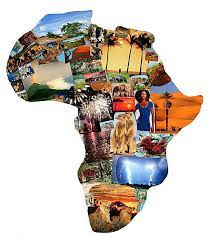Through the Lens of Time: Photography's Role in Preserving African Cultural Heritage
This article examines the crucial role of photography in safeguarding and promoting African cultural heritage within the context of globalization and modernization. We will explore how photographic documentation serves as a powerful tool for preserving traditions, fostering cultural identity, and facilitating intercultural understanding. Key concepts discussed include visual anthropology, archival science, and the application of semiotics in cultural preservation.
The Power of Visual Documentation: A Semiotic Approach
Photography, as a visual medium, offers a unique capacity for documenting cultural practices. Employing a semiotic lens, we can analyze photographs as sign systems, revealing deeper meanings embedded within cultural expressions. Images of traditional ceremonies, artistic creations, and daily life act as visual narratives, transmitting cultural knowledge and values across generations. This approach moves beyond simply recording events; it interprets the symbolic significance of visual elements, enriching our understanding of the culture represented. This aligns with the principles of visual anthropology, using photography as a method of ethnographic research and interpretation.
Building Cultural Archives: Strategies for Preservation
The creation and maintenance of comprehensive cultural archives are paramount. This involves systematically collecting, organizing, and preserving photographic materials relating to various aspects of African culture. Archival science principles, including appropriate storage conditions (temperature, humidity), digital preservation techniques (high-resolution scanning and metadata creation), and access protocols, must be implemented to ensure the longevity and accessibility of these valuable resources. The establishment of collaborative networks involving local photographers, historians, and community leaders is critical for generating accurate and representative collections that capture the breadth and depth of African cultural diversity. This collaborative approach directly addresses the potential for biased or incomplete representations often found in historical documentation.
Utilizing Photography for Education and Cultural Dissemination
Photography transcends mere documentation; it serves as a powerful educational tool. By showcasing the richness and diversity of African cultures, photographic exhibitions and online platforms can foster a sense of pride and identity among African youth, strengthening cultural transmission. Social media platforms, such as Instagram and Facebook, offer readily accessible channels for broad dissemination of cultural information. Dedicated pages and targeted hashtags effectively reach wider audiences, creating opportunities for intercultural dialogue and appreciation. The strategic use of photography aligns with educational theory emphasizing the importance of visual learning and experiential engagement. This form of knowledge dissemination supports the principles of cultural transmission and identity formation.
Capturing Cultural Evolution and Change
Effective cultural preservation encompasses not only the documentation of traditional practices but also the ongoing evolution of cultural expression. Photography can track the impacts of globalization, technological advancements, and migration on African cultures, providing crucial insight into processes of cultural adaptation and transformation. This longitudinal approach allows for a more nuanced understanding of cultural dynamism and resilience. By documenting both continuity and change, photography offers a comprehensive perspective on the complexities of cultural preservation.
National and International Collaboration
National institutions, such as national museums and archives, play a vital role in supporting the preservation of cultural heritage. Collaborative efforts between these institutions and local communities ensure that photographic projects are undertaken in a culturally sensitive and ethically responsible manner. Moreover, international cooperation through organizations such as UNESCO and the African Union can facilitate resource sharing, knowledge exchange, and the development of standardized preservation protocols. This coordinated approach maximizes the impact of preservation efforts and promotes a shared understanding of the importance of safeguarding global cultural heritage.
Conclusion and Recommendations
Photography provides an invaluable tool for preserving and promoting African cultural heritage. Through careful documentation, archiving, and dissemination, photographic images serve as powerful agents of cultural transmission, education, and intercultural understanding. The successful implementation of these strategies requires collaborative efforts between local communities, national institutions, and international organizations. Future research should focus on developing innovative methodologies for digital archiving, integrating oral histories with photographic documentation, and exploring new ways to utilize photography to engage diverse audiences in the preservation of African cultural heritage. The active engagement of African communities in all stages of the process is essential to ensure the ethical and effective preservation of their cultural heritage.
Reader Pool: How can the integration of emerging technologies, such as virtual reality and augmented reality, enhance the preservation and accessibility of African cultural heritage through photographic documentation?




